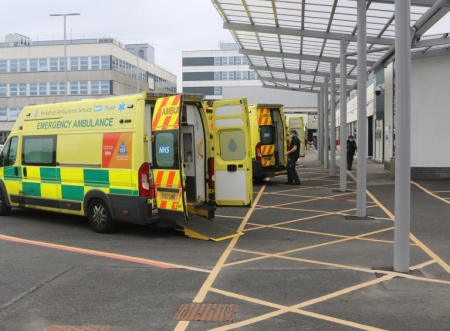
NHS staff working in A&E departments are in the middle of their busiest summer ever with a total of 4.6 million attendances over the last 2 months – higher than any other June and July, new figures show today.
The latest performance data shows that the 3 busiest ever months for A&E staff have been in 2024 (77,945 attendances per day in May, 76,469 in June and 74,459 in March).
Despite the pressure, hardworking NHS staff assessed and completed the treatment of more than three quarters (75.2%) of patients within 4 hours in A&E in July, the highest proportion since September 2021 but still well below the constitutional standard of 95%.
Ambulance services responded to 753,384 incidents last month, with 26,514 calls to 999 answered per day – up 6.2% on the same month last year. Average response times for category 1 (8:15) and 2 (33:25) calls were faster in July than in June, but still slower than the standards of 7 and 18 minutes respectively.
Hospitals reported that the overall waiting list for elective care rose again in June to 7.62 million, up 19,100 on May (7.60 million), with an estimated total of 6.39 million patients waiting. At the end of June, only 58.9% had been waiting less than the constitutional standard of 18 weeks, against a target of 92%.
Services faced 4 days of industrial action by junior doctors during this period (Thursday 27 June to Tuesday 2 July) with 61,989 acute appointments needing to be rescheduled, bringing the total cumulative impact on appointments since strikes first began to nearly 1.5 million.
On cancer, the NHS met the 28-day faster diagnosis standard for the second month in a row with more than three quarters of patients (76.3%) – almost 200,000 people – receiving the all clear or a definitive diagnosis within 4 weeks in June.
While there is more to do to ensure that people get timely cancer treatment, the number of people being referred for urgent checks for cancer remains high with almost 260,000 in June (259,681).
NHS staff delivered more diagnostic tests than in any other June with 2.33 million checks delivered, up more than a fifth on the same month pre-pandemic (1.93 million in June 2019). Despite the increased activity, almost a quarter (22.9%) of patients were still waiting more than 6 weeks.
Bed capacity remains under pressure in hospitals across the country with only 44.8% of patients discharged when they were ready last month, leading to an average of 12,326 patients a day spending more time in hospital than needed.
GP services across England also began collective action on Thursday 1 August and while there may be some disruption to services, practices remain open as usual and patients can make requests by phone, on-line or by walking in.
Professor Sir Stephen Powis, NHS National Medical Director said: “A&E staff are under significant pressure and the NHS is in the middle of what could be its busiest summer ever, with a total of 4.6 million attendances in the last 2 months alone and 2024 now having seen the 3 busiest months for A&E on record.
“While we have seen improvements in the number of patients seen and treated within 4 hours in A&E, slightly faster ambulance response times, and more than three quarters of cancer patients receiving an all clear or diagnosis in 4 weeks, it is clear that waits for patients across a range of services remain unacceptable and there is much more to do to deliver more timely care for those who need it.
“Nobody in the NHS wants to see patients experiencing long delays and we are committed to working with the government to create a 10-year plan for health that includes a clear plan to bring waits down.
“In the meantime, staff continue to work incredibly hard to deliver the best possible care for patients, and it is vital that people continue to come forward when they have health concerns”.
Background
The monthly performance statistics are available on the NHS England website.